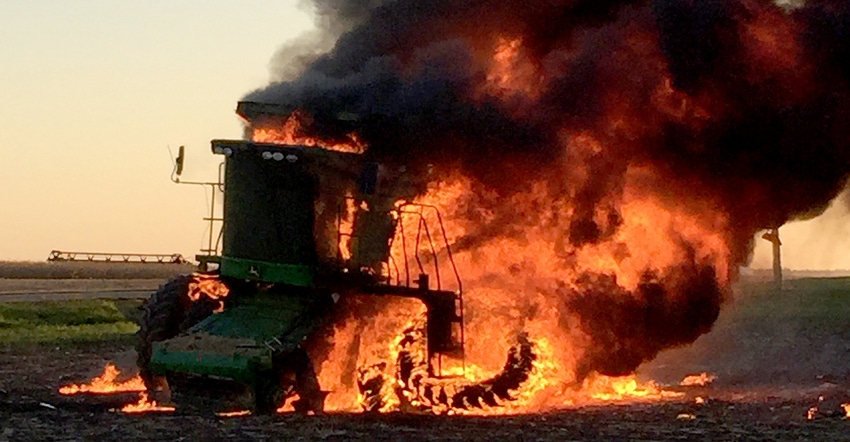October 3, 2022

While farmers hope harvest season passes with no problems, obstacles are simply routine. However, some extra work and troubleshooting during harvest can help prevent machinery fires and lost equipment.
Owen Coon, a volunteer firefighter and associate territory manager for Corteva Agriscience, recommends taking time daily to blow off any accumulated chaff from the combine.
“That chaff holds a lot of heat,” Coon says. “If something happens, it doesn’t take much for dry chaff to catch on fire.”
For farmers who don’t have time to blow off the entire machine, Coon recommends focusing on the beater bearing, the feederhouse above the grain or corn head and the engine bay.
“An easy way to do it is if you have an air compressor on a trailer that you can take with you to the field,” Coon says. “Today, a lot of people just carry a leaf blower.”
To aid in fire prevention, Coon says the biggest thing is making sure bearings are greased. Craig Green, assistant chief of the Monticello Fire Department in Monticello, Ind., reflects that advice.
“Machinery maintenance is huge [and] proper lubrication is … paramount,” he says.
Coon adds that machines should be checked daily for “hot spots.” Simply walk around the machine and check bearings that are heavily used to ensure they are not getting too hot.
Additional fire prevention measures can be taken weekly or on a rainy day during harvest.
Coon recommends going through the machine and opening all shields so everything can be thoroughly blown out and cleaned.
Belts should be checked carefully. Coon notes that a slipping belt can generate enough friction to start a fire. He says chains should also be checked to ensure they’re operating at the correct tension.
“Bearings, belts and, occasionally, chains are where hot spots are going to be,” he says. “Make sure everything is lubricated right and tension is set properly.”
Fire extinguishers
Fire extinguishers come in a variety of models, but they should all be checked annually. Coon recommends checking them before harvest season to ensure they are in good condition.
Bill Field, Purdue Extension farm safety specialist, explains that most farm machinery today comes equipped with a fire extinguisher from the manufacturer. The most important thing to check is that the needle in the pressure gauge is in the green. “That means the fire extinguisher is still under pressure,” Field says. Once the pressure drops, the needle will drop into the yellow or red section on the gauge. That’s when an extinguisher must be serviced or refilled.
Coon says local fire stations can provide guidance on where to take extinguishers for service. There is usually a small service fee.
Field adds that refilling a fire extinguisher can cost around $50, depending on the size of the unit. “You may want to establish a relationship with a company that services fire extinguishers,” he says. “You can find contacts for fire protection companies in your area through the yellow pages or through an internet search.”
Green notes that ABC fire extinguishers can damage equipment. The white powder is corrosive and can make a fire worse if it reaches the machine’s electrical components. However, they can be used to suppress a fire so long as care is taken to avoid electronics and other circuitry.
“There’s been instances where, if that fire extinguisher sits vertical, and you go to use it, the powder has settled out so much … that it doesn’t spray like it’s supposed to,” Coon says.
To avoid this problem, Field recommends turning a fire extinguisher on its side or upside down quickly when you grab it. Then return it to its normal position and use it. “Including that quick, simple step usually allows the fire extinguisher to function as intended,” he says.
Caught in a fire
If a fire happens to break out while the combine is in operation, Green says to immediately power down the machine and turn off all moving equipment. After the machine is turned off and the operator has found a spot at a safe distance, he or she should call 911.
“Give the best location you can possibly give,” Green says. “In a rural setting … intersecting county roads are the best.”
Green says providing an intersection that is close to the machine’s location in the field will get the firefighters to where they need to be.
If there is time and the operator feels comfortable, Green adds that fire suppression equipment can be used to maintain the fire while waiting for help.
“It’s inevitable [that] every year someone is going to have a fire,” Coon says. “Just make sure everybody on the crew has a plan and knows what’s going on.”
Lund is a student in the Purdue University agricultural communication program. Tom J. Bechman contributed to this story.
You May Also Like




